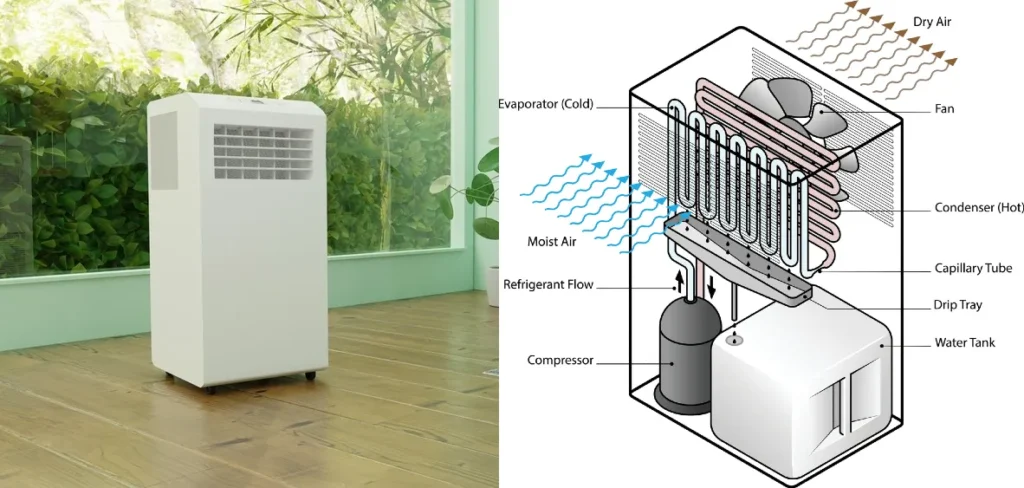How does a dehumidifier work
A dehumidifier is used to control humidity. If someone wants to reduce the moisture in their room, they should choose a dehumidifier.
If you look at the outside of a cold glass of water, you will notice water collecting on the surface. This happens because the glass temperature is lower than the outside air, because of this temperature difference a heat exchange process happens between them. As we all know, outside air contains moisture (H2O), which loses its heat during the heat exchange process. During this process, the H2O becomes heavier and collects on the outside of the glass.
A dehumidifier does exactly the same thing to remove moisture from the air. There are two kinds of dehumidifiers to control the humidity in a room. 1st one is a refrigerant-type dehumidifier which absorbs moisture from the air using a refrigeration cycle. If a house is in a place where the humidity level is high and, despite proper ventilation, you still face issues like wall or floor sweating, a refrigerant dehumidifier is the right choice.
2nd one is the Desiccant type which absorbs moisture from the air using a chemical reaction through a desiccant wheel. It is mostly used in industrial areas where someone needs more precise control over humidity.
I have personally worked with both systems before. In this blog, I will share drawings from both projects so that anyone can easily understand how these systems work and how they are used in practical applications.
Refrigerant Dehumidifier:
A refrigerant dehumidifier works exactly like the refrigeration cycle. If you know how the refrigeration cycle or an air conditioner works, you’ll understand how a refrigerant-type dehumidifier operates.
In a dehumidifier the evaporator, condenser, compressor, expansion valve, and blower fan are contained within a single unit, whereas in an air conditioner, they are split between two units: the indoor unit and the outdoor unit. The evaporator and EEV (Electronic Expansion Valve) are part of the indoor unit, while the compressor, condenser, and expansion valve are part of the outdoor unit.
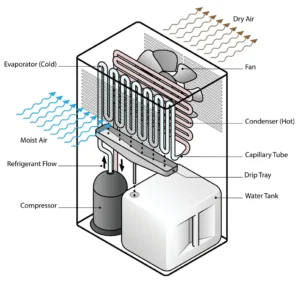
In a refrigerant dehumidifier, chilled liquid refrigerant flows to the evaporator, causing the evaporator’s temperature to drop below room temperature. In front of the evaporator and condenser, there is a blower fan that pulls room air into the dehumidifier. Inside, a heat exchange occurs between the warm room air and the cold refrigerant in the evaporator. The evaporator absorbs heat from the room air, transforming the refrigerant into a gas. At this point, the moisture in the air becomes heavier, condenses, and sticks to the evaporator, effectively dehumidifying the air.
The refrigerant, now in a hot gaseous state, moves into the compressor, which compresses it into a superheated gas. This high-pressure, superheated refrigerant gas then flows to the condenser, where it loses heat and returns to its liquid state. The liquid refrigerant passes through the expansion valve, which reduces its pressure and sends it back to the evaporator, completing the cycle.
In the beginning, I explained why water collects on the outside of a cold glass of water; the evaporator works in the same way.
In a refrigerant dehumidifier, the evaporator and condenser are positioned side by side. When the blower fan pulls room air into the evaporator and the evaporator removes moisture, the air becomes cold. This cold air then moves directly to the condenser, which is located just behind the evaporator. The cold, dehumidified air absorbs heat from the condenser, bringing it back to room temperature before being released back into the room. Through this heat exchange process, the dehumidified air is returned to the room at a normal temperature, while the refrigerant cycles back through the expansion valve to the evaporator.
The water collected inside the dehumidifier is drained out through a pipe.
Using a refrigerant dehumidifier is very simple. Just place it in the desired location, connect it to a power source, set up the drain line, and turn it on. That’s all there is to it!
Example:
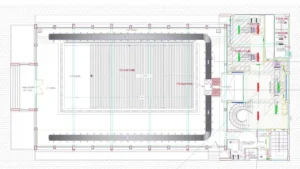
This was one of my projects, a swimming pool and gym area. As you can see, in swimming pool areas, we use refrigerant-type dehumidifiers. Why do we need a dehumidifier here?
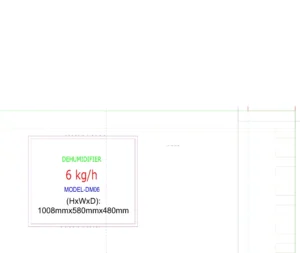
As we know, water in a swimming pool naturally evaporates. This creates high humidity levels in the area. The air conditioner takes in air from the pool area through the return line, cools it, and sends it back via the supply line. Without a dehumidifier, the air conditioner would continuously circulate the moist air. This would make the space uncomfortable and damp. That’s why a dehumidifier is essential for such areas.
Desiccant Dehumidifier:
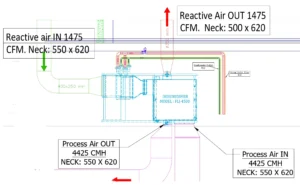
The desiccant dehumidifier is completely different from the refrigerant dehumidifier. Basically, a desiccant dehumidifier uses silicon gel to absorb moisture from the air. Silicon gel can absorb water up to 40% of its weight. The main component of a desiccant dehumidifier is the desiccant rotor. Before explaining further, it is important to describe how the desiccant rotor works.
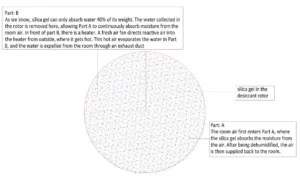
The desiccant rotor in the dehumidifier rotates slowly. As shown in the picture, the desiccant rotor has two parts: Part A absorbs moisture from the room air, and Part B evaporates the moisture so the collected water can be exhausted outside.
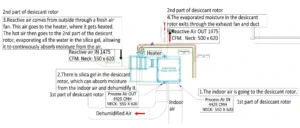
Imagine a desiccant dehumidifier has four air inlet and outlet lines. Room air enters the dehumidifier through the first line and passes to Part A of the desiccant rotor, where the silicon gel on the rotor absorbs the moisture from the air. This dehumidified air returns to the room through the second line of the dehumidifier.
The third and fourth lines work with Part B of the desiccant rotor. A fresh air line is connected to the third line, where a fresh air fan draws in reactive air from outside. This air passes through a heater in the dehumidifier, becoming hot. The hot air flows through Part B of the desiccant rotor and evaporates the collected water.
The fourth line is an exhaust line with an exhaust fan, which expels the evaporated air outside.
It’s a simple, practical, and easy-to-use device to control humidity in homes, swimming pool areas, chip and dried fruit factories, chemical industries, pharmaceutical areas, etc.

In pharmaceutical areas, humidity control is crucial because the places where medicines are manufactured have specific humidity requirements. If a dehumidifier is not used, the moisture in the air can react with the medicine, destroying its quality and shelf life. Consuming such medicine can harm patients and, in extreme cases, cause death. During processing or packaging, the humidity level in the room must be kept low. If regular air enters the package during packing, the moisture in the air will ruin the medicine inside.
Similarly, chip or dried fruit factories have specific humidity requirements. Even a small change in humidity can ruin an entire production, causing significant losses for the company. Dehumidifiers ensure the air remains dry and your favorite snacks stay crisp and fresh. Without a dehumidifier, maintaining the crispness of these products is impossible. They are a vital part of the production process.
Dehumidifiers are also used for storing important documents, expensive equipment, antique artworks, etc. They protect these items from moisture damage.
It makes our homes and workplaces more comfortable. In summer, when air moisture increases, it can make the air feel thick or cause a musty smell in a damp basement. This is where a dehumidifier comes to the rescue. Its job is simple: it removes moisture from the air, ensuring a healthier, more comfortable, and pleasant environment.
Comfort isn’t the only reason to use a dehumidifier. High humidity isn’t just annoying; it can cause real damage to health. High humidity can lead to wall sweating, electrical accidents, and damage to wooden products. A dehumidifier acts as a silent friend, protecting your home, health, and belongings by reducing moisture, preventing mold and dust, and making the air cleaner, healthier, and more breathable.
Maintenance:
Like every mechanical or electrical tool, you need to perform some maintenance work on a dehumidifier. For example, you need to clean the filter every three months. If your place has a lot of dust, clean it every two months. If the filter gets clogged with dust, the dehumidifier cannot pull air from your room and will not operate properly. If the dehumidifier has a water reservoir, clean it properly. To achieve long-lasting performance, you need to maintain and take care of it.
Honestly, nothing’s perfect, and dehumidifiers can have some issues. If it’s making a weird noise or it feels like it’s not removing enough moisture, most of the time, these issues are easy to fix. Sometimes, you just need to clean the filter to solve the issue, or the temperature in the room/area is too low for a refrigerant dehumidifier. For cold weather, if you use a desiccant dehumidifier, you can get a better result. That’s why you need to choose the right dehumidifier for your place.
Dehumidifiers are mandatory for specific places. They quietly work in any setting, making life easier and more comfortable. Whether it’s a damp basement, a factory full of sensitive products, or just a muggy living room, a dehumidifier is an easy solution for you. From improving air quality to protecting your home and valuables, you can easily choose a dehumidifier.

